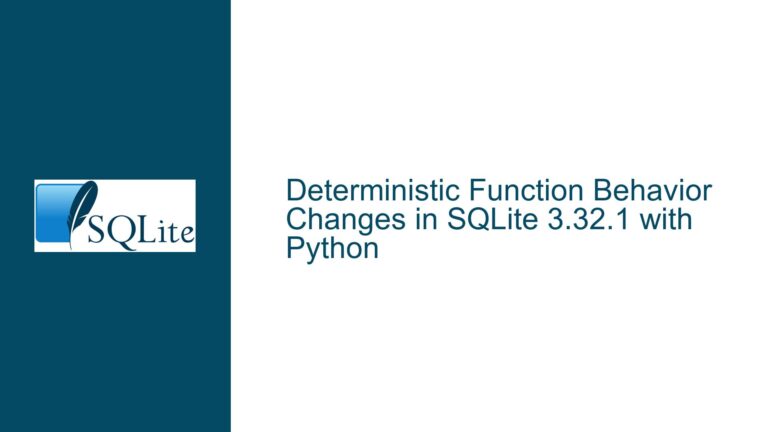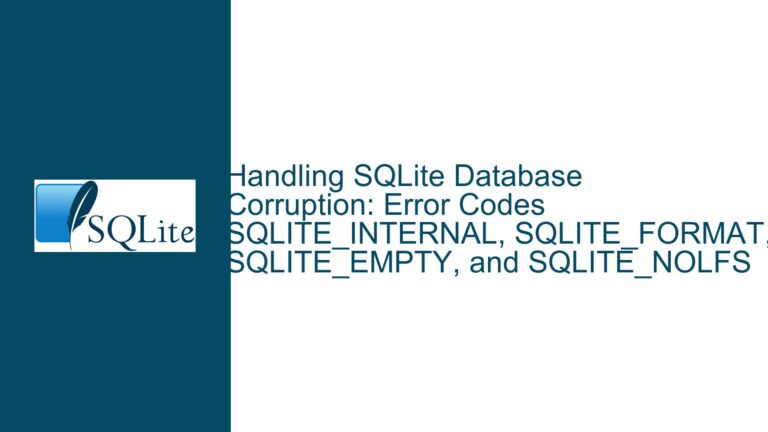SQLite Row Updates and Index Behavior in Detail
How SQLite Handles Row Updates and Index Modifications
SQLite, as a lightweight and embedded database, has a unique approach to handling row updates and index modifications. The core of this behavior revolves around how SQLite manages data storage, transactional integrity, and performance optimizations. When a row is updated, SQLite’s internal mechanisms determine whether the entire row needs to be rewritten or if only specific parts of the row are modified. This decision is influenced by factors such as the size of the row, the type of data being updated, and whether the updated columns are part of any indexes. Additionally, SQLite’s transactional model ensures that changes are atomic and durable, which further impacts how updates are processed at the page level.
One of the key aspects of SQLite’s update mechanism is its handling of variable-length columns. Since SQLite stores all column values as variable-length data, any change in the length of a column value can necessitate a rewrite of the entire row. This is because the positions of subsequent columns may need to be adjusted to accommodate the new length. However, if the updated column’s length remains unchanged, and the row spans multiple pages, SQLite can optimize the update by only rewriting the affected pages. This optimization is particularly relevant when dealing with large rows that contain BLOBs or other large data types.
Indexes in SQLite are another critical factor in how updates are handled. When a column that is part of an index is updated, SQLite must also update the corresponding index entries. This ensures that the index remains consistent with the underlying table data. However, if the updated column is not part of any index, SQLite can skip the index update step, which can lead to performance improvements. This behavior is crucial for understanding how to design efficient schemas and queries in SQLite, as it highlights the importance of carefully considering which columns to index.
The Impact of Row Size and Page-Level Transactions on Updates
The size of a row and the way SQLite handles page-level transactions play a significant role in determining the efficiency of updates. SQLite’s storage model is based on pages, which are fixed-size blocks of data typically ranging from 512 bytes to 64 KB. When a row is updated, the entire page containing that row is typically written to the journal file as part of the transaction. This ensures that the database can recover to a consistent state in the event of a crash or power failure. However, this also means that even a small change to a single byte within a page can result in the entire page being written to disk.
For large rows that span multiple pages, SQLite can optimize updates by only rewriting the pages that contain modified data. For example, consider a row that contains an integer followed by a 1 MB BLOB. If the integer is updated and its on-disk encoding size remains the same, only the first page of the row (which contains the integer) needs to be rewritten. The pages containing the BLOB do not need to be modified, as their positions within the row remain unchanged. This optimization can significantly reduce the I/O overhead associated with updating large rows, especially when dealing with BLOBs or other large data types.
However, if the updated column’s length changes, SQLite may need to rewrite the entire row, including any BLOBs or other large data types. This is because the positions of subsequent columns may need to be adjusted to accommodate the new length. In such cases, the I/O overhead can be substantial, particularly if the row contains large BLOBs. This behavior underscores the importance of carefully considering the design of your schema and the types of data you store in SQLite, especially when dealing with large rows.
Optimizing SQLite Updates: Schema Design and Query Considerations
To optimize updates in SQLite, it is essential to consider both schema design and query patterns. One of the most effective ways to improve update performance is to minimize the number of indexed columns. As mentioned earlier, SQLite only updates indexes when the indexed columns are modified. Therefore, by reducing the number of indexed columns, you can reduce the overhead associated with index updates. This is particularly important for tables that are frequently updated, as index maintenance can become a significant bottleneck.
Another important consideration is the placement of large data types, such as BLOBs, within a row. Since SQLite updates entire rows by default, placing large BLOBs at the end of a row can help minimize the impact of updates. If a non-BLOB column is updated and its length remains unchanged, SQLite may only need to rewrite the pages containing the non-BLOB data, leaving the BLOB pages untouched. This can significantly reduce the I/O overhead associated with updating rows that contain large BLOBs.
Additionally, it is important to consider the use of transactions when performing updates. SQLite’s transactional model ensures that changes are atomic and durable, but it also means that each update operation involves writing to the journal file. By batching multiple updates within a single transaction, you can reduce the number of journal writes and improve overall performance. This is particularly relevant for applications that perform a large number of small updates, as the overhead of starting and committing transactions can become significant.
Finally, it is worth noting that SQLite does not support certain optimizations, such as HOT (Heap-Only Tuples) updates, which are available in other databases like PostgreSQL. HOT updates allow for more efficient updates by avoiding unnecessary index modifications when non-indexed columns are updated. While SQLite does not support HOT updates, understanding the limitations and trade-offs of its update mechanism can help you design more efficient schemas and queries.
Practical Steps to Diagnose and Optimize SQLite Update Performance
When diagnosing and optimizing update performance in SQLite, there are several practical steps you can take. First, it is important to analyze the schema and identify any columns that are frequently updated but not part of any indexes. These columns are good candidates for optimization, as they do not require index updates when modified. By reducing the number of indexed columns, you can minimize the overhead associated with index maintenance and improve update performance.
Next, consider the placement of large data types within your rows. If your table contains large BLOBs, try to place them at the end of the row to minimize the impact of updates. This can help reduce the I/O overhead associated with rewriting large rows, especially when only non-BLOB columns are updated. Additionally, consider breaking up large rows into multiple tables if possible. For example, you could store BLOBs in a separate table and reference them using a foreign key. This can help reduce the size of individual rows and improve update performance.
Another important step is to analyze your query patterns and identify any opportunities for batching updates within transactions. By batching multiple updates within a single transaction, you can reduce the number of journal writes and improve overall performance. This is particularly relevant for applications that perform a large number of small updates, as the overhead of starting and committing transactions can become significant.
Finally, consider using tools like SQLite’s EXPLAIN QUERY PLAN to analyze the performance of your queries and identify any potential bottlenecks. This can help you understand how SQLite is executing your queries and identify any areas for optimization. For example, you may discover that certain queries are causing full table scans or unnecessary index updates, which can be optimized by modifying the schema or query.
Conclusion: Balancing Performance and Consistency in SQLite Updates
In conclusion, SQLite’s approach to handling row updates and index modifications is designed to balance performance and consistency. By understanding the underlying mechanisms, you can design more efficient schemas and queries that take advantage of SQLite’s optimizations while minimizing the impact of updates. Key considerations include minimizing the number of indexed columns, carefully placing large data types within rows, and batching updates within transactions. Additionally, using tools like EXPLAIN QUERY PLAN can help you diagnose and optimize query performance.
While SQLite does not support certain optimizations like HOT updates, its flexible and lightweight design makes it a powerful choice for many applications. By carefully considering the design of your schema and the types of data you store, you can achieve high performance and reliability in your SQLite databases. Whether you are working on a small embedded system or a large-scale application, understanding SQLite’s update behavior is essential for building efficient and maintainable databases.






